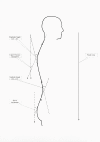Sagittal jaw position in relation to body posture in adult humans--a rasterstereographic study
- PMID: 16448563
- PMCID: PMC1379641
- DOI: 10.1186/1471-2474-7-8
Sagittal jaw position in relation to body posture in adult humans--a rasterstereographic study
Abstract
Background: The correlations between the sagittal jaw position and the cranio-cervical inclination are described in literature. Only few studies focus on the sagittal jaw position and the body posture using valid and objective orthopaedic examination methods. The aim of this study was to test the hypothesis that patients with malocclusions reveal significant differences in body posture compared to those without (upper thoracic inclination, kyphotic angle, lordotic angle and lower lumbar inclination).
Methods: Eighty-four healthy adult patients (with a mean age = 25.6 years and ranging from 16.1 to 55.8 years) were examined with informed consent. The orthodontic examination horizontal overjet (distance between upper and lower incisors) was determined by using an orthodontic digital sliding calliper. The subjects were subdivided in respect of the overjet with the following results: 18 revealed a normal overjet (Class I), 38 had an increased overjet (Class II) and 28 had an reversed overjet (Class III). Rasterstereography was used to carry out a three-dimensional back shape analysis. This method is based on photogrammetry. A three-dimensional shape was produced by analysing the distortion of parallel horizontal white light lines projected on the patient's back, followed by mathematical modelling. On the basis of the sagittal profile the upper thoracic inclination, the thoracic angle, the lordotic angle and the pelvic inclination were determined with a reported accuracy of 2.8 degrees and the correlations to the sagittal jaw position were calculated by means of ANOVA, Scheffé and Kruskal-Wallis procedures.
Results: Between the different overjet groups, no statistically significant differences or correlations regarding the analysed back shape parameters could be obtained. However, comparing males and females there were statistically significant differences in view of the parameters 'lordotic angle' and 'pelvic inclination'.
Conclusion: No correlations between overjet and variables of the thoracic, lordotic or the pelvic inclination could be observed.
Figures

Similar articles
-
Relationship between back posture and early orthodontic treatment in children.Head Face Med. 2021 Feb 5;17(1):4. doi: 10.1186/s13005-021-00255-5. Head Face Med. 2021. PMID: 33546715 Free PMC article.
-
Postural changes in orthodontic patients treated with clear aligners: A rasterstereographic study.J Electromyogr Kinesiol. 2018 Feb;38:44-48. doi: 10.1016/j.jelekin.2017.11.002. Epub 2017 Nov 14. J Electromyogr Kinesiol. 2018. PMID: 29156321 Clinical Trial.
-
Sagittal spinal posture in relation to craniofacial morphology.Angle Orthod. 2006 Jul;76(4):625-31. doi: 10.1043/0003-3219(2006)076[0625:SSPIRT]2.0.CO;2. Angle Orthod. 2006. PMID: 16808569
-
Non-structural misalignments of body posture in the sagittal plane.Scoliosis Spinal Disord. 2018 Mar 5;13:6. doi: 10.1186/s13013-018-0151-5. eCollection 2018. Scoliosis Spinal Disord. 2018. PMID: 29516039 Free PMC article. Review.
-
Head and Cervical Posture in Sagittal Skeletal Malocclusions: Insights from a Systematic Review.J Clin Med. 2025 Apr 11;14(8):2626. doi: 10.3390/jcm14082626. J Clin Med. 2025. PMID: 40283455 Free PMC article. Review.
Cited by
-
Impact of occlusal stabilization splints on global body posture: a prospective clinical trial.Clin Oral Investig. 2024 Aug 29;28(9):505. doi: 10.1007/s00784-024-05888-9. Clin Oral Investig. 2024. PMID: 39207547 Free PMC article. Clinical Trial.
-
Influence of non-traumatic thoracic and lumbar vertebral fractures on sagittal spine alignment assessed by radiation-free spinometry.Osteoporos Int. 2013 Jun;24(6):1859-68. doi: 10.1007/s00198-012-2156-x. Epub 2012 Oct 13. Osteoporos Int. 2013. PMID: 23064371
-
Relationship between back posture and early orthodontic treatment in children.Head Face Med. 2021 Feb 5;17(1):4. doi: 10.1186/s13005-021-00255-5. Head Face Med. 2021. PMID: 33546715 Free PMC article.
-
The relationship between cervical column curvature and sagittal position of the jaws: using a new method for evaluating curvature.Iran J Radiol. 2011 Nov;8(3):161-6. doi: 10.5812/kmp.iranjradiol.17351065.3379. Epub 2011 Nov 25. Iran J Radiol. 2011. PMID: 23329934 Free PMC article.
-
Impact of manual therapy on body posture-3-D analysis with rasterstereography - pilotstudy.Head Face Med. 2024 Sep 13;20(1):49. doi: 10.1186/s13005-024-00450-0. Head Face Med. 2024. PMID: 39272140 Free PMC article.
References
-
- Michelotti A, Manzo P, Farella M, Martina R. Occlusion and posture: is there evidence of correlation? Minerva Stomatol. 1999;48:525–534. - PubMed
-
- Solow B, Siersback-Nielsen S. Cervical and craniocervical posture as predictors of craniofacial growth. Am J Orthod Dentofacial Orthop. 1992;101:449–458. - PubMed
Publication types
MeSH terms
LinkOut - more resources
Full Text Sources
Medical

